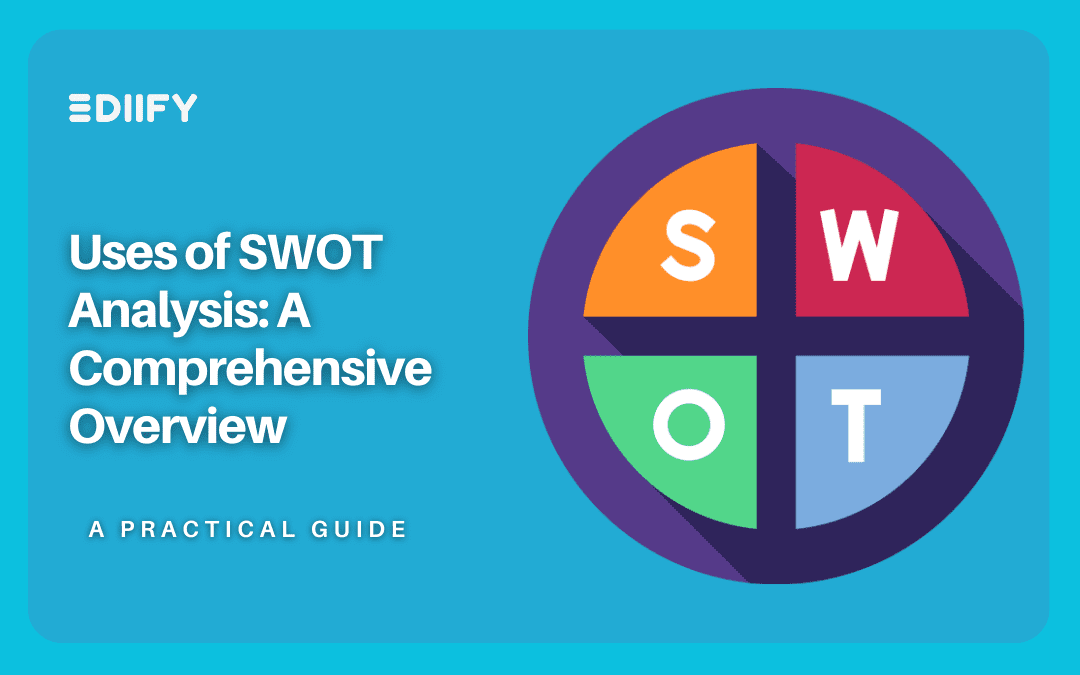Introduction:
In the dynamic realm of business and organizational management, achieving and maintaining success requires a thorough understanding of both internal and external factors that can influence outcomes. Strategic planning is an integral part of navigating uncertainties and capitalizing on opportunities. Among the array of tools available to strategists, the SWOT analysis stands out as a structured framework that evaluates an entity’s Strengths, Weaknesses, Opportunities, and Threats. This comprehensive approach provides a panoramic view, guiding organizations toward sustainable growth and success.

Understanding SWOT:
The SWOT analysis is a versatile and user-friendly method that serves as a compass for decision-makers across diverse industries. Its simplicity lies in breaking down the intricate reality of an organization into four distinct categories:
Take a look at the below blog exploring the benefits of self-assessment
https://ediify.com/exploring-the-benefits-of-self-assessment/
- Strengths:
- Internal attributes that provide the organization with a competitive advantage.
- Examples include a skilled workforce, advanced technology, a robust brand reputation, and efficient processes.
- Weaknesses:
- Internal factors that impede the organization’s performance.
- These may involve outdated technology, a lack of skilled personnel, or internal processes in need of improvement.
- Opportunities:
- External factors that the organization can exploit for its benefit.
- Opportunities may arise from market trends, emerging technologies, or gaps in the competition.
- Threats:
- External elements that pose challenges to the organization.
- Threats may include economic downturns, industry competition, and regulatory changes.
Take a view at the below blog on the importance of swot analysis
https://ediify.com/importance-of-swot-analysis/
Uses of SWOT Analysis:
- Strategic Planning:
- SWOT analysis lays the foundation for strategic planning, helping identify the organization’s current position and guiding the formulation of future objectives.
- Decision-Making:
- When confronted with critical decisions, the SWOT analysis provides a systematic evaluation of the pros and cons, enabling informed and balanced choices.
- Resource Allocation:
- By understanding internal strengths and weaknesses, organizations can allocate resources more effectively, optimizing strengths and mitigating weaknesses.
- Risk Management:
- Identifying threats is crucial for effective risk management. SWOT analysis allows organizations to proactively address potential challenges and develop contingency plans.
- Market Positioning:
- Assessing strengths and opportunities enables organizations to position themselves effectively in the market. Understanding weaknesses and threats helps mitigate risks associated with market dynamics.
Take a look at the blog mitigation strategies below. Use the principle of something
https://ediify.com/mitigation-strategies-uses-the-principle-of-something/
Conclusion:
In the constantly evolving business landscape, organizations that embrace strategic analysis are better equipped to navigate uncertainties and capitalize on opportunities. The SWOT analysis, with its simplicity and effectiveness, serves as a guiding tool for decision-makers, facilitating informed choices and the development of resilient strategies. Regularly revisiting and updating the uses of SWOT analysis enables organizations to adapt to changing circumstances, staying ahead in the competitive race. Embracing this strategic tool is not merely a choice; it signifies a commitment to continuous improvement and sustainable success.

For more information visit the mentioned website
https://corporatefinanceinstitute.com/resources/management/swot-analysis/


